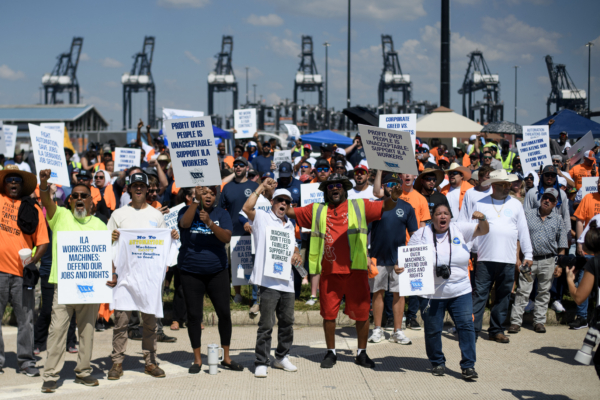On Tuesday, 45,000 dockworkers from 36 ports stretching from the East Coast to the South in the United States began a strike, marking their first strike since 1977 and leading to the closure of about half of the container ports across the nation. Analysts say the impact of this strike on American livelihoods and the economy will depend on how long the strike persists.
According to a report by CBS News on Tuesday, Daniel Munch, an economist from the American Agricultural Union, stated to CBS MoneyWatch, “Each day of the strike results in a backlog of containers and vessels. A strike lasting three to five days would require two weeks to clear, and if the strike continues for three weeks, it may not be resolved until early January.”
This strike signifies that there could soon be shortages of bananas and cherries in American grocery stores. These two fruits, imported chocolates, specialty meats, and over a hundred other food items rely on the now closed docks. Munch believes that these products may soon be in high demand and short supply.
According to data from the American Agricultural Bureau, over 75% of bananas imported to the U.S. arrive at these ports. Munch pointed out that apart from perishable fruits, nearly 90% of imported cherries, 85% of canned goods, 82% of peppers, and 80% of chocolates arrive via cargo ships through these ports for unloading.
New York Governor Kathy Hochul warned of a potential shortage of bananas at a news conference at the Port Authority headquarters on Monday. She mentioned, “I don’t want to say ‘yes, we have no bananas,’ but we may get there.”
Andrew Coggins, a clinical professor of management and management science at Pace University’s Lubin School of Business, stated, “Within two to three weeks, you should start seeing shortages. This is a big deal, especially if it persists for a long time.”
Furthermore, the automobile industry may also face direct consequences, with Hochul advising prospective car buyers to call ahead. She mentioned, “If you were hoping to buy a new car this week, you might need to check with the dealer, as deliveries may not arrive in the coming weeks.”
The Bureau also indicated that beverages could face a shortage or price increase risk, as 80% of imported beer, wine, whiskey, and Scotch, along with 60% of rum, arrive at ports in the East and the Gulf of Mexico and could experience demand-supply imbalances.
The strike may also pose difficulties for American farmers and the export of agricultural products, leading to surplus domestic production.
Munch stated, “By volume, about 14% of U.S. agricultural products exported through waterways are at risk.” Within a week, “the potential value of obstructed agricultural exports is estimated at $318 million.”
Although an extended strike could drive up commodity prices nationwide and result in shortages, some retailers have indicated that they are prepared for disruptions in the supply chain.
The large grocery retail chain H-E-B, headquartered in Texas, released a statement on Tuesday, assuring customers that they do not expect the port strike to affect them. They stated, “Our team has been working with suppliers for several weeks to serve Texans. Most products are not expected to be impacted by this strike.”
According to data from the Center for Land Use Interpretation (CLUI), 90% of toilet paper consumed in the U.S. is domestically produced, with over 80% coming from three American companies: Procter & Gamble, Kimberly-Clark, and Georgia-Pacific. The remaining 10% of imports mostly come from Canada and Mexico.
The CLUI report also mentioned that the flow of toilet paper in the supply chain remains relatively stable and balanced. Hence, although panic buying could lead to some empty shelves, this situation is not expected to last long.
Jonathan Gold, Vice President of Supply Chain and Customs Policy at the National Retail Federation, the largest retail trade group in the U.S., stated that the strike occurred during the peak shipping season for retailers’ holiday seasons, traditionally running from July to early November. Many major retailers anticipated the strike, thus shipping goods to the U.S. as early as June, with most ordered products already in the country. However, restocking will pose challenges for retailers.
The strike could last for weeks or even months. Consumers might not notice any significant shortages if the strike ends within a few weeks. However, a strike lasting over a month could potentially lead to shortages of certain consumer goods. While most holiday retail items have been imported, shoppers may see increased prices across a wide range of products from fruits and vegetables to automobiles.

